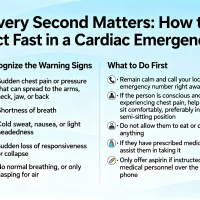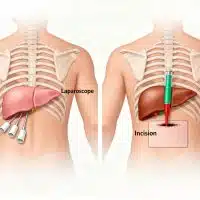
Gastric Balloon is a non-surgical weight loss procedure that involves placing a deflated balloon in the stomach to promote feelings of fullness and reduce appetite. This procedure is often recommended for individuals who have struggled to lose weight through diet and exercise alone. The balloon is typically made of silicone and is filled with either saline solution or air. Once inserted, it takes up space in the stomach, making the individual feel full even when they consume smaller portions of food.
How Does a Gastric Balloon Work?
The gastric balloon works by physically occupying space in the stomach, resulting in reduced food intake and caloric restriction. When the balloon is inserted, it expands and takes up a significant portion of the stomach’s volume. As a result, the individual feels full more quickly and has a decreased appetite. The balloon also slows down the emptying of the stomach, leading to a prolonged feeling of fullness. This combination of physical and physiological effects helps individuals lose weight by consuming fewer calories.
The gastric balloon is only a temporary solution and is typically left in place for a period of six months. After this time, the balloon is removed, and the individual continues their weight loss journey with the guidance of a healthcare professional.
Benefits of Using a Gastric Balloon
- Non-surgical: Unlike other weight loss procedures, a gastric balloon does not require any incisions or sutures. It is a minimally invasive procedure that can be performed on an outpatient basis, reducing the risk of complications and promoting a quicker recovery time.
- Effective weight loss: Studies have shown that individuals who undergo gastric balloon treatment experience significant weight loss. On average, patients lose between 20% to 30% of their excess weight within the six-month period the balloon is in place.
- Improved health outcomes: Losing weight through a gastric balloon can have a positive impact on various health conditions associated with obesity, such as type 2 diabetes, high blood pressure, and sleep apnea. By reducing excess weight, individuals may experience improved overall health and quality of life.
Risks and Side Effects of a Gastric Balloon
While a gastric balloon is generally considered safe, there are potential risks and side effects that individuals should be aware of before considering the procedure.
- Nausea and vomiting: It is common for individuals to experience nausea and vomiting in the initial days or weeks after the balloon is inserted. This is due to the body adapting to the presence of the foreign object in the stomach. These symptoms can usually be managed with medication and tend to subside over time.
- Gastric discomfort: Some individuals may experience discomfort or a feeling of heaviness in the stomach due to the presence of the balloon. This usually resolves as the body adjusts to the balloon.
- Ulceration or erosion: In rare cases, the gastric balloon may cause ulceration or erosion in the stomach lining. This can lead to symptoms such as abdominal pain, bleeding, or infection. It is important to report any unusual symptoms to a healthcare professional immediately.
- Balloon deflation or migration: Although uncommon, there is a risk of the balloon deflating or migrating within the stomach. If this occurs, it may require immediate medical attention to avoid complications.
It is essential to discuss the potential risks and side effects with a qualified healthcare professional before deciding to undergo a gastric balloon procedure.
Who is a Suitable Candidate for a Gastric Balloon?
A gastric balloon is typically recommended for individuals who have a body mass index (BMI) between 30 and 40 and have been unsuccessful in achieving significant weight loss through diet and exercise alone. It is important to note that a gastric balloon is not a solution for morbid obesity, and more invasive weight loss procedures may be recommended for individuals with a BMI greater than 40.
Candidates for a gastric balloon should also have a commitment to making long-term lifestyle changes, including adopting a healthy diet and engaging in regular physical activity. The procedure is most effective when combined with a comprehensive weight loss program that includes ongoing support and guidance from healthcare professionals.
The Gastric Balloon Insertion Procedure
The insertion of a gastric balloon is typically performed by a gastroenterologist or bariatric surgeon in an outpatient setting. The procedure usually takes around 20 to 30 minutes and is done under sedation or general anesthesia.
During the procedure, a thin tube with a deflated balloon attached to the end is inserted through the mouth and into the stomach. Once the balloon is in place, it is filled with either saline solution or air, depending on the type of balloon used. Once filled, the tube is removed, leaving the balloon in the stomach.
After the procedure, individuals will be monitored for a short period to ensure there are no immediate complications. They will then be provided with post-insertion care instructions and guidelines for diet and lifestyle changes.
Post-Insertion Care and Lifestyle Changes
Following the insertion of a gastric balloon, individuals are required to make significant lifestyle changes to maximize the effectiveness of the procedure and promote long-term weight loss. These changes may include:
- Dietary modifications: A healthcare professional will provide guidance on adopting a healthy and balanced diet that is low in calories and high in nutrients. This may involve reducing portion sizes, avoiding high-calorie foods, and focusing on consuming lean proteins, fruits, vegetables, and whole grains.
- Regular exercise: Engaging in regular physical activity is essential for maintaining weight loss and overall health. A healthcare professional will provide recommendations for appropriate exercise routines and activities based on an individual’s fitness level and health condition.
- Behavioral counseling: Changing eating habits and maintaining long-term weight loss can be challenging. Behavioral counseling can provide individuals with the necessary tools and strategies to overcome emotional eating, develop healthy coping mechanisms, and establish a positive relationship with food.
It is crucial for individuals to actively participate in their post-insertion care and follow the guidance provided by healthcare professionals to achieve the best possible outcomes.
Gastric Balloon vs Other Weight Loss Methods
When considering weight loss methods, individuals may wonder how a gastric balloon compares to other options available. Here is a comparison of a gastric balloon with other common weight loss methods:
- Diet and exercise: While diet and exercise are fundamental components of weight loss, some individuals may struggle to achieve significant and sustainable weight loss through these methods alone. A gastric balloon can provide an initial jump-start to weight loss efforts, helping individuals see tangible results that can motivate further lifestyle changes.
- Medications: Prescription weight loss medications can be effective for certain individuals, but they often come with potential side effects and may not be suitable for everyone. A gastric balloon offers a non-pharmacological approach to weight loss with minimal systemic side effects.
- Bariatric surgery: Bariatric surgery, such as gastric bypass or sleeve gastrectomy, is a more invasive weight loss option that involves permanent alterations to the digestive system. These procedures are typically recommended for individuals with a BMI greater than 40 or those with significant obesity-related health conditions. A gastric balloon, on the other hand, is a temporary solution that can be considered for individuals with a lower BMI who do not meet the criteria for bariatric surgery.
Ultimately, the choice of weight loss method depends on individual circumstances, preferences, and guidance from healthcare professionals.
Success Stories and Testimonials
Many individuals have found success with a gastric balloon in their weight loss journey. Here are a few testimonials:
- Jane Doe: “I struggled with my weight for years and tried various diets without much success. Getting a gastric balloon was a turning point for me. It helped me control my portion sizes and change my eating habits. I lost 25% of my excess weight within six months and have been able to maintain it with a healthier lifestyle.”
- John Smith: “As a busy professional, I found it challenging to commit to a strict diet and exercise routine. The gastric balloon provided the jump-start I needed to see results quickly. It gave me the motivation to make lasting changes in my lifestyle, and I lost 30% of my excess weight within the six months the balloon was in place.”
These success stories highlight the potential benefits of a gastric balloon in achieving significant weight loss and improving overall health.
Frequently Asked Questions About Gastric Balloons
- How long does the gastric balloon procedure take?
The procedure usually takes around 20 to 30 minutes, but the overall time spent in the hospital may be longer due to pre- and post-procedure care.
- Is a gastric balloon covered by insurance?
In some cases, insurance may cover the cost of a gastric balloon, but it depends on the individual insurance policy and the specific circumstances. It is recommended to check with the insurance provider for coverage details.
- Will I be able to eat normally with a gastric balloon?
While a gastric balloon restricts the amount of food that can be consumed, individuals can still eat a variety of foods. However, it is important to follow the dietary guidelines provided by healthcare professionals to achieve the best weight loss outcomes.
- Are there any long-term effects of a gastric balloon?
The effects of a gastric balloon are temporary, as the balloon is typically removed after six months. Long-term weight loss maintenance requires ongoing lifestyle changes and follow-up care.
- Can the gastric balloon be removed earlier than six months?
In some cases, the gastric balloon may be removed earlier than six months if there are complications or if the individual experiences intolerable side effects. A healthcare professional will determine the appropriate timing for removal based on individual circumstances.
Conclusion
A gastric balloon is a non-surgical weight loss option that can help individuals achieve significant weight loss when combined with a comprehensive lifestyle change program. It provides a temporary solution for individuals who have struggled to lose weight through diet and exercise alone. While the procedure is generally safe, it is essential to consider the potential risks and side effects before deciding to undergo a gastric balloon insertion.
If you are interested in learning more about gastric balloons and whether they are suitable for your weight loss goals, please call BIMC Nusa Dua for more information. Our team of healthcare professionals can provide guidance and support throughout your weight loss journey. Take the first step towards a healthier lifestyle today!











